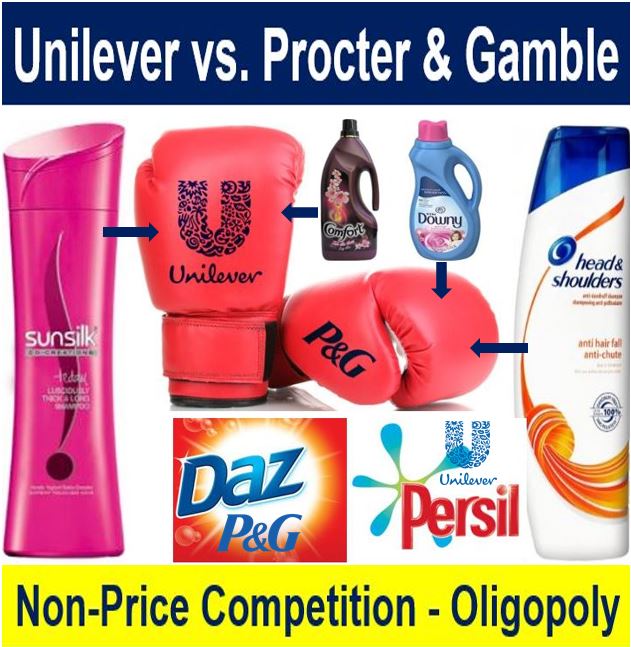Non-price competition refers to competition between companies that focuses on benefits, extra services, good workmanship, product quality – plus all other features and measures that do not involve altering prices. It contrasts with price competition, in which rivals try to gain market share by reducing their prices.
Non-price competition is a marketing strategy that typically includes promotional expenditures such as sales staff, sales promotions, special orders, free gifts, coupons, and advertising.
Put simply, it means marketing a firm’s brand and quality of products, rather than lowering prices. Most companies across the world are involved in either non-price competition, price competition, or both.
 Non-price competition strategies include comparing your product to a rival’s, showing that what you sell has been certified by a well-known ecological organization, and constantly promoting your brand name and logo.
Non-price competition strategies include comparing your product to a rival’s, showing that what you sell has been certified by a well-known ecological organization, and constantly promoting your brand name and logo.
Non-price competition – oligopolies
Non-price competition is more common in markets where there is imperfect competition, such as those with very few competitors – oligopolies – maybe because it can give an impression of a very competitive market, when in fact the rivals are colluding to keep their prices high.
Non-price competition is an important strategy in marketplaces where sellers are offering their service as a product, such as AirBnB, Fiverr, oDesk, TaskRabbit, Mechanical Turk, etc. In these marketplaces, suppliers tend to distinguish themselves in terms of customer satisfaction, speed of delivery, quality, etc.
Non-price competition – two phases
There are typically two phases to a non-price competition strategy. The first implements new aspects of production or services, while the second lets consumers know about them.
 The Economist describes non-price competition as follows: “Trying to win business from rivals other than by charging a lower price. Methods include advertising, slightly differentiating your product, improving its quality, or offering free gifts or discounts on subsequent purchases. Non-price competition is particularly common when there is an oligopoly, perhaps because it can give an impression of fierce rivalry while the firms are actually colluding to keep prices high.”
The Economist describes non-price competition as follows: “Trying to win business from rivals other than by charging a lower price. Methods include advertising, slightly differentiating your product, improving its quality, or offering free gifts or discounts on subsequent purchases. Non-price competition is particularly common when there is an oligopoly, perhaps because it can give an impression of fierce rivalry while the firms are actually colluding to keep prices high.”
For example, if a company reduces the packaging around a product, it will save on materials, weight, and shelf space. It may draw attention to a message on the packaging that says: “New packaging, same fantastic product!”
By changing the packaging, the product’s price is not lowered, and neither is its quality or workmanship undermined.
Non-price competition – pros & cons
There are several advantages associated with this type of marketing campaign:
- Better sales tactics, including social media posts, efficient forms of online advertising, and direct sales through the manufacturer.
- Improved product quality.
- Different presentation of products for varied demographics. For example, sales may increase if the same product is presented differently for men and women.
- Superior brand perception. Brands provide guidance and clarity for choices made by firms, consumers, investors and other stakeholders.
Disadvantage:
The main drawback is that consumers are not likely to notice the changes straight away – which is not the case when prices are lowered.
 Cincinnati-based Procter & Gamble Co. (P&G) and London/Rotterdam-based Unilever plc (Unilever NV), are the major players in the global household consumer goods market – which is currently an oligopoly. Their matching products are always virtually identically priced. The two companies focus on advertising, promotions, competitions, special offers, and different packaging and presentations to make their goods and brands stand out in the marketplace.
Cincinnati-based Procter & Gamble Co. (P&G) and London/Rotterdam-based Unilever plc (Unilever NV), are the major players in the global household consumer goods market – which is currently an oligopoly. Their matching products are always virtually identically priced. The two companies focus on advertising, promotions, competitions, special offers, and different packaging and presentations to make their goods and brands stand out in the marketplace.
Non-price competition – pharma companies
The pharmaceutical industry is full of brand name products and generics, which become available when the active ingredient’s patent has expired.
Companies face strong pricing competition from businesses that manufacture generic equivalents of their brand-name medications.
However, in virtually every case, the brand-name owner avoids reacting with pricing strategies, and instead uses a non-price competition marketing approach.
For example, the brand name Tylenol is owned by McNeil Consumer Healthcare, a subsidiary of Johnson & Johnson. Even though the active ingredients and dosages of Tylenol are exactly the same as its generic equivalents, marketing the brand name’s quality and superiority still works, and results in healthy profits.
Non-price competition – McDonald’s
McDonald’s, the American hamburger and fast food restaurant giant, uses a wide range of both non-price and price competition. It claims to buy coffee beans that are ‘fair trade’ and have the ‘Rainforest Alliance Group’ seal of approval.
This is an effective way for McDonald’s to boost sales because it does not have to alter the price of the cups of coffee it sells.
In nearly every McDonald’s restaurant across the globe today, it offers free Wi-Fi. Through bulk-buying and negotiating a lower price for the purchase of several internet connections, the company has been able to increase sales without the need for the high costs involved with a major advertising campaign.
In New Zealand, McDonald’s was able to differentiate its product, avoiding the need for major changes. To improve public opinion in New Zealand, the company switched to free-range eggs, which helped the franchise improve its reputation in the country as one that values animal welfare — as well as adhering to the country’s Animal Welfare Code of Welfare.
Video – Non-price competition – Definition and Meaning
This video explains what non-price competition is. The speaker says it consists of two branches: 1. Advertising, and 2. Product development.
